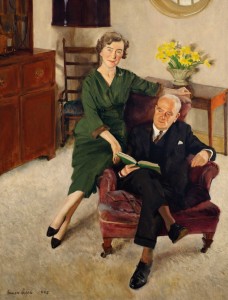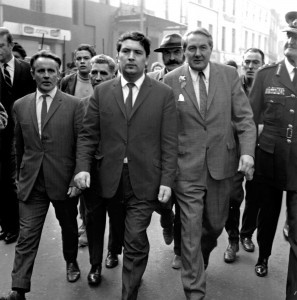A university gerrymander? Coleraine and the Lockwood Report
Published in Features, Issue 5 (September/October), Northern Ireland 1920 - present, Volume 22
Sir John Lockwood, Master (1951–1965), and Lady Lockwood by Norman Hepple. (Birkbeck College, University of London)
‘The only consideration which activated the minds of the Unionist powers . . . was that two-thirds of the population of Londonderry were Catholics. They sited the university in the heart of Coleraine . . . [a] unionist-dominated area.’
This assertion in Gerry Fitt’s maiden speech at Westminster in 1966 is still widely believed, but is it supported by contemporary evidence, in particular by recently released documents?
More undergraduate places needed
In the 1960s Stormont wanted additional undergraduate places, prompting discussions with Britain’s University Grants Committee (UGC). (The UGC dispersed treasury funds and set standards.) Sir John Lockwood, master of Birkbeck College, London, was named to chair a wide-ranging inquiry, whose options included expanding Queen’s University, Belfast, with possibly a second university. The brief did not specify recommending the location of any new university, so why, suspicious minds wondered, did they propose Protestant Coleraine?
Papers in the Public Records Office of Northern Ireland (PRONI) show that in 1963 the Lockwood committee—four English academics and four locals—began their inquiry with the assumption that the UGC and Stormont would decide the location. The committee decided early on that a second university was needed—urgently. There were four contenders—Armagh City, Coleraine, Derry, with Stormont officials wanting the university in the planned new city between Lurgan and Portadown (Craigavon). The committee intended the new institution to be complementary to Queen’s but geographically distant. Their criteria narrowed a small field, leading Sir John to ask whether they should recommend somewhere. The UGC thought that this ‘might be advantageous as it would be extremely difficult to consider what a new university might do without having regard to its probable location’.
As half the committee comprised UGC nominees (one a UGC member), Stormont agreed. Submissions from rival towns show that they too expected Sir John to name the winner. Derry regarded its Magee University College as the clincher; ironically, it handicapped the city. When Sir John visited in 1964, Magee trustees were perhaps too frank about deficiencies in classrooms and laboratories. Tutorials were held in the entrance hall. The committee thought that Magee was physically cramped, with a ‘circumscribed mental outlook’, and ‘could not be adjudged the best nucleus for major expansion’. In his detailed analysis of the Lockwood papers Gerard O’Brien says that the committee thought Derry councillors complacent in assuming a right to the university because of Magee. When the committee suggested a university in the city excluding Magee, the discussion in the Guildhall became heated. Committee minutes refer to the danger of Magee asserting ‘squatters’ rights’ should an alternative Derry site be chosen.

John Hume (centre) with Home Secretary James Callaghan (right), visiting Derry’s Bogside in August 1969. Less than five years earlier, Hume had chaired a cross-community ‘University for Derry Campaign’. (Larry Doherty)
If the new university incorporated Magee, the Derry college’s reputation might deter top candidates from seeking posts. Coleraine was off the academic radar but lobbied hard. The treasury was restricting funds UK-wide for purpose-built student residences. Coleraine argued that summer guesthouses and flats in Portrush and Portstewart would save money—Sussex and Essex universities used seaside accommodation. Supporters did extensive research, e.g. on the potential for marine biology.
Coleraine received no official encouragement. When in February 1962 the Chamber of Commerce sought a meeting with Terence O’Neill (then finance minister responsible for university funding), he said that ‘it would be premature’ as ‘we have by no means reached the stage at which there is any question of considering possible sites’. Two years later finance minister Jack Andrews refused to meet a Coleraine delegation: ‘. . . it would not be proper for me to consider evidence from a particular locality or, indeed, to influence the committee in any way in reaching its findings’. Derry and Armagh were told the same. Craigavon was different—supported by William Craig, minister for health and local government, whose remit included the new city. Other localities had councillors and chambers of commerce. Craigavon was still on the drawing board, so Craig’s senior civil servants argued its case for the university. The fact that Craigavon existed only on paper perturbed the committee. Craigavon and Armagh were also thought too near Queen’s to evolve distinctively. Coleraine, thought the committee, while not ideal, ‘satisfies our criteria better than any of the other areas’—though its observation that its ‘proximity to Londonderry would soothe hurt feelings’ beggars belief!
O’Brien describes the pressures on committee members—geographically dispersed, a punishing timetable and operating against civil service politicking—but he does not doubt their integrity. Several Stormont mandarins challenged Coleraine’s suitability, objections later echoed in Derry. Their principle concern, though, was Craigavon’s rejection—‘a vote of no confidence in the new city’—from which it might not recover. There were ‘grave political dangers’ in allowing Sir John’s experts to recommend a location. It could cause ‘embarrassment’ if the cabinet overruled them.
Ministers received the 300-page Lockwood Report in November 1964. In Craig’s absence, his junior minister told the cabinet of their ‘disappointment’ about Craigavon. Commerce minister Brian Faulkner said that Coleraine was not his preference, adding that Lockwood had now made it ‘more difficult’ for the new city [Craigavon]—though on location ‘the views of the eminent educationists . . . could not be set aside’. At a subsequent meeting, William Morgan (Craig’s replacement at health) rather weakly suggested that a university in Coleraine might ‘have a detrimental effect’ on tourism in Portrush and Portstewart! Agriculture minister Harry West asked ‘whether a location on the outskirts of Londonderry would not be an acceptable compromise’. The thorniest problem was Lockwood’s rationale that, with the treasury being asked to fund a new university nearby, Magee’s grant from Stormont (two-thirds of its budget) should end. One minister said that this would ‘throttle’ Magee. Faulkner said that it would ‘kill Magee and offend people in Londonderry’.
Indecision delayed publication, as ‘extremely fanciful’ rumours swept Derry. The chief whip envisaged ‘a dangerous and powerful lobby consisting of disgruntled people’ from Londonderry, Armagh and Lurgan/ Portadown, allied with Magee supporters everywhere. Education minister Herbert Kirk was sympathetic to Magee ‘on grounds of sentiment and tradition’. But adhering to Lockwood was key to retaining UGC support, thus securing treasury funds, without which there would be no second university. Should the report be ‘flaunted’, said another minister, the UGC might walk away.
The details were leaked in late 1964, prompting the formation of a cross-community ‘University for Derry Campaign’, chaired by John Hume. A stormy public meeting at the Guildhall ahead of publication (February 1965) heard that the city was being ‘written off’ and ‘strangled’ (the train service to Portadown had just been closed). The Derry Journal spoke of the ‘justice of Derry’s claim’. Catholic bishop Dr Neil Farren said: ‘Derry is entitled to a university’.
Queen’s politics professor John Whyte later observed that Lockwood ‘produced reasoned arguments’ for Coleraine—e.g. room for expansion—that Magee could not match. Derry wasn’t interested. Unionist mayor Albert Anderson (‘I don’t care what the government’s decision is or whose government’s decision it is’) was cheered by nationalists who normally denounced him for gerrymandering Londonderry Corporation! Anderson led thousands in a motorcade to Stormont.
The united front crumbled when unionists on the county education committee backed Lockwood. The Londonderry Sentinel reported a meeting where Attorney General Edward Jones, a local Unionist MP, told dejected party members that ditching Lockwood would not win the university for Derry but might lose it for Northern Ireland. O’Neill decided to save Magee, as closing it risked creating a storm that ‘could capsize the entire report’. Nationalists dismissed assurances on Magee and depicted the growing acceptance of Lockwood by unionists as ‘the Orange machine controlling events’.
The New University of Ulster (NUU) opened in Coleraine in 1968 as civil rights demonstrators marched, convinced of a university gerrymander. Magee survived to join NUU in 1969 (formally in 1970), giving Derry part of the university, though arguments continued about its subordinate status. Today it is a successful campus of the revamped University of Ulster.
So did Sir John get it wrong? Replying to criticism that Coleraine was an arbitrary choice, he said: ‘In my own experience most choices have to be arbitrary. What other way is there of choosing?’
John Draper is a journalist living in London.
Read More: Magee College
‘Nameless, faceless, men’?
No Catholics on the Lockwood committee
Further reading
G. O’Brien, ‘Our Magee problem’, in idem (ed.), Derry and Londonderry: history and society (Dublin, 1999).


















